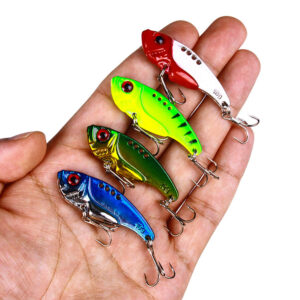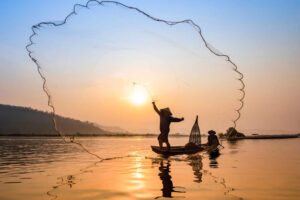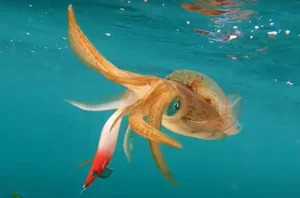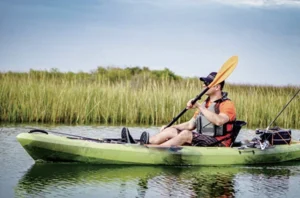مقدمة
Whether you’re casting your line from the peaceful shores of a serene lake or venturing out onto the open waters aboard a sturdy boat, fishing holds a special place in the hearts of countless individuals worldwide. It offers a perfect blend of tranquility and excitement, where the gentle rhythm of casting and reeling in is met with eager anticipation for that exhilarating tug on the line.Fishing isn’t just catching fish-it’s relaxing in nature and making memories with people you love. So gather your gear, embrace the serenity of the water, and embark on a soul-rejuvenating angling adventure.
1.Monofilament Fishing Lines
For حدود الصيد للسمك, monofilament is tough to beat. Made from a single nylon strand, it bends and stretches like no other. If you’re an expert angler or just starting out, monofilament has you covered – it comes in all sorts of colors, thicknesses, and strengths to match your fishing style and needs. Hooking a lunker bass or chasing stocked trout, this line won’t let you down. Mono stretches and absorbs shock when you need it, yet stays strong on the hookset. However you fish, monofilament shines as a top choice for supreme flexibility and reliability. This user-friendly line works wonders for newbies and veterans alike.From delicate finesse fishing to handling heavyweight trophies, monofilament lines have got you covered. For any fishing trip can be on these line – they’re versatile, dependable, and excel in every angling adventure.
Pros of Monofilament Fishing Lines
- Affordable: Monofilament lines are typically more affordable than other types of fishing lines.
- Versatile: They can be used for a variety of fishing applications, from freshwater to saltwater fishing.
- Stretchability: Monofilament lines have some stretchability, making them suitable for catching fish that tend to make sudden movements.
Cons of Monofilament Fishing Lines
- Memory: Monofilament lines tend to have memory, which means they can retain their shape after being spooled, making them more prone to tangling.
- Low abrasion resistance: Monofilament lines have lower abrasion resistance than other types of fishing lines, making them more likely to break when fishing in rocky or snaggy areas.

2.Braided Fishing Lines
Another popular type of fishing line is braided line. Braided lines are made by weaving together multiple strands of synthetic fibers like Spectra or Dyneema. strong,sensitive – that’s their rep for minimal stretch and trusted performance.
Pros of Braided Fishing Lines
- High strength: Braided lines are known for their high strength-to-diameter ratio, making them ideal for fishing in heavy cover or for big game fish.
- Low stretch: Braided lines have low stretch, making it easier to detect bites and hook fish.
- Sensitive: The lack of stretch in braided lines makes them more sensitive, allowing you to feel even the slightest nibble.
Cons of Braided Fishing Lines
- الرؤية: Braided lines are often more visible in the water than other types of fishing lines, which can make fish more wary.
- Expensive: Braided lines can be more expensive than other types of fishing lines.
- Difficulty in knot tying: Braided lines can be more difficult to tie knots in due to their slippery surface.
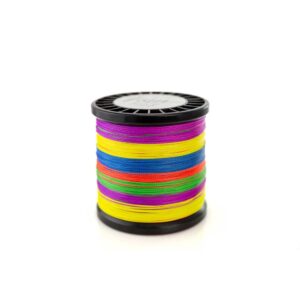
3.Fluorocarbon Fishing Lines
The Fluorocarbon fishing lines is made of a special plastic that seems to disappear into the water – fish cannot spot it. That’s why it’s the angler’s first choice when fishing in clear lakes and rivers.They are made from a single strand of fluorocarbon and have similar properties to monofilament lines..
Pros of Fluorocarbon Fishing Lines
- Nearly invisible: Fluorocarbon lines are nearly invisible in water, making them a good choice for fishing in clear water or when fish are finicky.
- Abrasion-resistant: Fluorocarbon lines have high abrasion resistance, making them a good choice for fishing in rocky or snaggy areas.
- Sensitive: Fluorocarbon lines are more sensitive than monofilament lines, allowing you to feel even the slightest bite.
Cons of Fluorocarbon Fishing Lines
- Expensive: Fluorocarbon lines can be more expensive than other types of fishing lines.
- Lack of stretch: Fluorocarbon lines have less stretch than monofilament lines, making them more likely to break when fighting big fish.
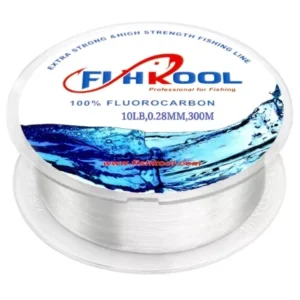
4.Copolymer Fishing Line
Copolymer fishing line is a recent advancement. It combines different types of nylon to create a versatile fishing line. It features a stiffer, abrasion-resistant coating over a softer core material. This combination allows copolymer lines to cast well and withstand rough conditions.
Copolymers are thinner than monofilament and offer excellent sensitivity and strength. They also have less line memory, which means they are less prone to tangling. Copolymer lines are suitable for various fishing techniques. They provide a good balance between strength and flexibility.
5. Different Colors of Fishing Lines
The color of your fishing line can have an impact on your fishing success. A clear fishing line is ideal for sharp-eyed fish in clear water, as it is less visible underwater. High-visibility lines are great for bait fishing and trolling. Anglers need to keep a close eye on the line to detect bites and prevent tangles.
Braided fishing lines come in color-coded models. The color patterns change every 30 feet. This feature helps anglers check the depth of their lure. Camo fishing lines feature mottled color patterns. They break up the line’s profile in stained or dirty water. Yellow, orange, blue, and bright green lines are easier to see in bright sunshine or at night. They’re suitable for trolling or managing many lines.
6. Choosing the Right Fishing Line for Different Fish
Different types of fish need different fishing lines to maximize success. Here are some recommendations for specific fish species:
Trout Fishing Line
Trout have sharp eyesight and often live in clear water. Anglers targeting trout should use the lightest, clearest fishing line possible. Eight-pound test clear monofilament is a popular choice. It allows the lure or bait to have the most action in the current. Monofilament’s abrasion resistance is also beneficial when fishing in rocky areas.
Bass Fishing Line
Bass fishing requires a versatile approach, with anglers using various lures and tactics. For most applications, a 10- to 15-pound line is suitable for bass fishing. Many anglers opt for a 10-pound braided line with a 12-inch leader of 20-pound fluorocarbon. This setup allows for a combination of strength, sensitivity, and invisibility.
Fishing Line for Different Reels
The type of fishing line to use on a bait caster depends on personal preference and fishing style. Monofilament is often favored for its ease of use and untangling properties. Use a braided line when you want the largest sensitivity and long casting distance. It is important to match the line weight to the reel’s specifications. This ensures optimal performance.
7. Fishing Line Weight and Strength
Fishing lines come in a range of weights, denoted as pound test or lb. You measure the breaking strength of a fishing line in pounds of pressure required to break it. The general rule of thumb is to use the lightest line that can withstand the weight of the average fish you will be targeting. Lighter lines offer better casting performance and can make the fight with a big fish more challenging and exciting.
The choice of fishing line weight depends on the fish species and fishing conditions. For general fishing, use a 10-pound line and a 15-pound leader. This setup can catch a variety of freshwater and saltwater fish. However, heavier lines may be necessary in heavy structures. They may also be necessary when fishing for trophy-sized fish.
8. Fishing Line Strength Test
The pounds of pressure required to break the line determine the strength of the fishing line. Manufacturers label their lines with the breaking strength in the pound test. However, variations in diameter and performance can affect how the line breaks. Choose a line with the thinnest diameter to cast farther and move more easily.
9. Fishing Line Brands
Choosing the right fishing line brand is crucial to ensure quality and performance. Some popular fishing line brands include Fishkoolsports, Stren, Trilene, Sufix, Momoi, and Diamond. Each brand offers different features and strengths. It is advisable to research and read reviews to find the best line for your specific fishing needs.
10. When to Replace Fishing Line
للحفاظ على أدائه، يجب عليك استبدال خط الصيد بانتظام. استبدل خط الصيد أحادي الخيط في كل موسم. يمكن أن تتدهور مع مرور الوقت. استبدل قادة الفلوروكربون بعد كل رحلة صيد. يمكن أن يؤثر التعرض للأشعة فوق البنفسجية على عدم رؤيتهم وقوتهم. وبالتالي فإن الخطوط المضفرة أكثر متانة ويمكن أن تستمر لسنوات مع الرعاية المناسبة. من المهم التحقق من الخطوط المضفرة بحثًا عن علامات التآكل أو تغير اللون. استبدلها حسب الضرورة.
11. منع التشابك ومشاكل الخطوط
يمكن أن تكون خطوط الصيد المتشابكة محبطة وتستغرق وقتًا طويلاً في التعامل معها. لمنع التشابك، تأكد من لف الخيط بشكل صحيح على البكرة. اترك البكرة في نفس الاتجاه الذي تسير فيه البكرة. يمكن أن تساعد إضافة قطب صغير إلى الخط أيضًا في منع التقلبات الناتجة عن بعض السحر.
يعد إبقاء خط الصيد محكمًا على البكرة أمرًا ضروريًا لتجنب التشابك. يمكن أن يتجمع الخط السائب ويحفر في نفسه، مما يؤدي إلى التشابك. يمكن أن يساعد الحفاظ على شد الخط بشكل صحيح أثناء لفه في منع هذه المشكلة.
12. التخلص من خط الصيد بشكل صديق للبيئة
نحن بحاجة إلى التخلص من خطوط الصيد بشكل صحيح للحد من تأثيرها على البيئة. تحتوي العديد من منحدرات الإطلاق وأرصفة الصيد ومحلات الأدوات على أوعية. وهي مصممة خصيصًا لجمع خطوط الصيد المستعملة. يمكن لمنتجات مختلفة إعادة استخدام هذه الخطوط. وهذا يقلل من النفايات ويحافظ على مواردنا الطبيعية.
الأسئلة الشائعة
س: ما هو نوع خط الصيد الأكثر شعبية؟
ج: أكثر أنواع خطوط الصيد شيوعًا هي الخطوط الأحادية والمضفرة والفلوروكربون.
س: ما هو نوع خط الصيد الأفضل لصيد الأسماك في المياه العذبة؟
ج: تعتبر الخطوط الأحادية خيارًا جيدًا لصيد الأسماك في المياه العذبة.
س: ما هو نوع خط الصيد الأفضل لصيد الأسماك في المياه المالحة؟
ج: تعتبر الخطوط المضفرة أو خطوط الفلوروكربون خيارًا جيدًا لصيد الأسماك في المياه المالحة.
س: هل يمكنني استخدام أنواع مختلفة من خطوط الصيد على نفس البكرة؟
ج: لا يُنصح عمومًا باستخدام أنواع مختلفة من خطوط الصيد على نفس البكرة، حيث يمكن أن يكون لها خصائص مختلفة قد تؤثر على أداء الصيد الخاص بك.
خاتمة
Choosing the right fishing line is essential for a successful fishing trip, and with so many different types of fishing lines on the market, it can be overwhelming to know which one to choose. Monofilament, braided, and fluorocarbon lines are the most popular types of fishing lines, each with their own set of advantages and disadvantages. By considering the fishing conditions and target species, you can select the right diameter and type of line for your needs and reel in your catch with ease.
احصل على عرض أسعار فوري مع Fishkoolsports
هل أنت مهتم بصيد الأسماك؟ في Fishkoolsports، نحن نقدم مجموعة واسعة من منتجات الصيد including fishing lines, rods and reels, kayaks, and other fishing products at competitive prices. Reach out today for an instant quote.ابدأ مع Fishkoolsports لتبدأ رحلة الصيد الخاصة بك.


